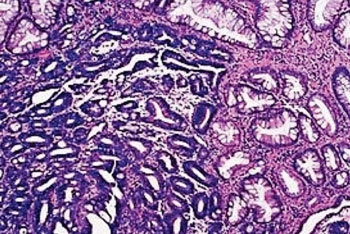Biomarker Helps Predict Stomach Cancer Survival
By LabMedica International staff writers
Posted on 17 Sep 2015
A biomarker has been identified in patients with stomach cancer that starves tumors of their blood supply and reduces the ability of cancer cells to spread to other parts of the body. Posted on 17 Sep 2015
In the USA, stomach cancer, also known as gastric cancer, most commonly affects older people, as around 60% of those diagnosed each year are over 65. Stomach cancer is most common in less developed countries, and it is a primary cause of cancer-related deaths worldwide.

Image: Histopathology of advanced gastric carcinoma of the intestinal type shows gland-forming adenocarcinoma and adjacent intestinal metaplasia (Photo courtesy of Drs. Shabnam Bashir and Sudip Raina).
Scientists at the Southern Medical University (Guangzhou, China) used a form of genetic analysis called quantitative real-time polymerase chain reaction (qRT-PCR) to detect micro ribonucleic acid 506 (miR-506) in human gastric samples taken from 84 people who had undergone cancer surgery. The team analyzed the miR-506 levels in each of these samples, and patients were allocated to different groups based on whether they were above or below the mean miR-506 level.
They found that miR-506 expression was a useful marker for stratifying patients from early to advanced clinical stages and for overall survival prediction. Overexpression of miR-506 inhibited the epithelial-to-mesenchymal transition of gastric cancer cells; however, depletion of miR-506 promoted it. In addition, miR-506 suppressed gastric cancer angiogenesis and was associated with decreased matrix metalloproteinase-9 expression. They also found that V-Ets Avian Erythroblastosis virus E26 Oncogene Homolog 1 (ETS1) was a miR-506 target, and it was expressed in 71.10% of gastric cancer tissue samples. At 60 months, cumulative survival was approximately 30% in the low-miR-506 expression group, compared with 80% in the high-expression group.
The team then looked at signs of miR-506 in seven stomach cancer cell lines. Here, it was found that stomach cancer cells had lower levels of miR-506 than normal stomach tissue. Analysis of cells grown in vitro then showed that miR-506 levels were lowest in the cell lines that had the highest invasive activity, and the highest levels were seen in cell lines with the lowest invasive activity.
Xin Song, MD, PhD, the lead investigator, said, “Our findings indicate that miR-506 is necessary and sufficient for angiogenesis suppression during gastric cancer progression. Cancer is a complex disease and controlling cancer development and progression requires system level and integrative approaches. Our study suggests that miR-506 acts as a tumor suppressor in gastric cancer." The study was published on September 8, 2015, in the American Journal of Pathology.
Related Links:
Southern Medical University














